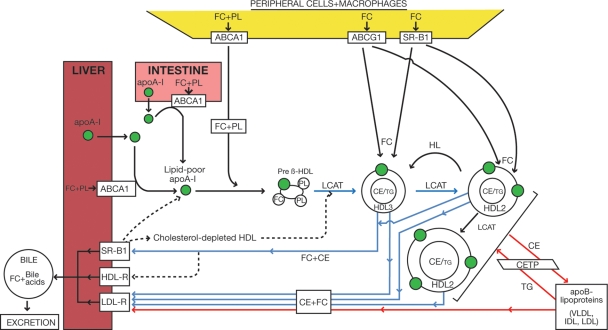Figure 1.
Pathways of reverse cholesterol transport in man. The reverse cholesterol transport system involves lipoprotein-mediated transport of cholesterol from peripheral, extra-hepatic tissues, and arterial tissue (potentially including cholesterol-loaded foam cell macrophages of the atherosclerotic plaque) to the liver for excretion, either in the form of biliary cholesterol or bile acids. The ATP-binding cassette transporters, ABCA1 and ABCG1, and the scavenger receptor B1, are all implicated in cellular cholesterol efflux mechanisms to specific apoA-I/HDL acceptors. The progressive action of lecithin:cholesterol acyl transferase on free cholesterol in lipid-poor, apolipoprotein A-I-containing nascent high-density lipoproteins, including pre-β-HDL, gives rise to the formation of a spectrum of mature, spherical high-density lipoproteins with a neutral lipid core of cholesteryl ester and triglyceride. Mature high-density lipoproteins consist of two major subclasses, large cholesteryl ester-rich HDL2 and small cholesteryl ester-poor, protein-rich HDL3 particles; the latter represent the intravascular precursors of HDL2. The reverse cholesterol transport system involves two key pathways: (a) the direct pathway (blue lines), in which the cholesteryl ester content (and potentially some free cholesterol) of mature high-density lipoprotein particles is taken up primarily by a selective uptake process involving the hepatic scavenger receptor B1, and: (b) an indirect pathway (red lines) in which cholesteryl ester originating in high-density lipoprotein is deviated to potentially atherogenic very low-density lipoprotein, intermediate-density lipoprotein, and low-density lipoprotein particles by cholesteryl ester transfer protein. Both the cholesteryl ester and free cholesterol content of these particles are taken up by the liver predominantly via the low-density lipoprotein receptor which binds their apoB100 component. This latter pathway may represent up to 70% of cholesteryl ester delivered to the liver per day.51 The hepatic low-density lipoprotein receptor is also responsible for the direct uptake of high-density lipoprotein particles containing apoE; apoE may be present as a component of both HDL2 and HDL3 particles, and may be derived either by transfer from triglyceride-rich lipoproteins, or from tissue sources (principally liver and monocyte-macrophages). Whereas high-density lipoprotein uptake by the low-density lipoprotein receptor results primarily in lysosomal-mediated degradation of both lipids and apolipoproteins, interaction of high-density lipoprotein with scavenger receptor B1 regenerates lipid-poor apoA-I and cholesterol-depleted high-density lipoproteins, both of which may re-enter the HDL/apoA-I cycle.27 LPL, lipoprotein lipase; PL, phospholipids; HDL-R, holo HDL receptor; HL, hepatic lipase.

